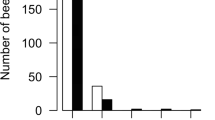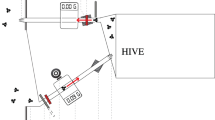Abstract
Resin is an important building material in the nests of honeybees, but little is known about how it is handled within the nest and how its collection is controlled. We studied the functional organization of resin work to better understand how a colony adaptively controls its intake of resin. Two hypotheses have been proposed for how resin collectors stay informed of the need for additional resin: (1) the unloading difficulty hypothesis (resin need is sensed indirectly by the unloading delay) and (2) the caulking activity hypothesis (resin need is sensed directly while engaged in using resin). A falsifiable prediction of the latter hypothesis, but not of the former, is that resin collectors not only gather resin outside the hive but also regularly handle resin inside the hive (taking it from other bees and using it to caulk crevices). Consistent with this prediction are our findings that in the resin sector of a colony’s economy, unlike in the pollen, nectar, and water sectors, there is no strict division of labor between the collectors and the users of a material. Over the course of a day, bees seen collecting resin were also commonly seen using resin. Moreover, we found that the unloading locations of resin collectors are unlike those of water and nectar collectors, being deep inside the hive (at the sites of resin use) rather than at the hive entrance. This arrangement facilitates the engagement in resin use by resin collectors. We conclude that the caulking activity hypothesis is well-supported, but that the unloading difficulty hypothesis also remains viable, for we found that resin collectors experience variable delays in getting rid of their loads, from less than 15 min to more than an hour, consistent with this hypothesis. The stage is now set for experimental tests of these two hypotheses. Both may be correct, which if true will imply that social insect workers, despite their small brains, can acquire and integrate information from multiple sources to improve their knowledge of conditions within the colony.










Similar content being viewed by others
References
Bassindale R (1955) The biology of the stingless bee Trigona (Hypotrigona) gribodoi Magretti. Proc Zool Soc Lond 125:49–62
Bonabeau E, Theraulaz G, Deneubourg J-L, Aron S, Camazine S (1997) Self-organization in social insects. Trends Ecol Evol 12:188–193
Butler CG (1954) The world of the honeybee. Collins, London
Camazine S, Deneubourg J-L, Franks NR, Sneyd J, Theraulaz G, Bonabeau E (2001) Self-organization in biological systems. Princeton Univ. Press, Princeton, NJ
Crane E (1990) Bees and beekeeping. Cornell Univ. Press, Ithaca, NY
Franks NR (1999) Information flow in the social domain: how individuals decide what to do next. In: Detrain C, Deneubourg J-L, Pasteels JM (eds) Information processing in social insects. Birkhäuser-Verlag, Basel
Hepburn HR (1986) Honeybees and wax. Springer, Berlin Heidelberg New York
Huber F (1814) Nouvelles observations sur les abeilles. Barde, Manget and Co, Geneva
Kühnholz S, Seeley TD (1997) The control of water collection in honeybee colonies. Behav Ecol Sociobiol 41:407–422
Lindauer M (1948) Über die Einwirkung von Duft- und Geschmacksstoffen sowie anderer Faktoren auf die Tänze der Bienen. Z Vgl Physiol 31:348–412
Lindauer M (1952) Ein Beitrag zur Frage der Arbeitsteilung im Bienenstaat. Z Vgl Physiol 34:299–345
Lindauer M (1954) Temperaturregulierung und Wasserhaushalt im Bienenstaat. Z Vgl Physiol 36:391–432
Meyer W (1954) Die “Kittharzbienen” und ihre Tätigkeiten. Z Bienenforsch 2:185–200
Meyer W (1956) “Propolis bees” and their activities. Bee World 37:25–36
Michener CD (1974) The social behavior of the bees. Harvard Univ. Press, Cambridge, MA
Morse RA (1975) Bees and beekeeping. Cornell Univ. Press, Ithaca, NY
Ratnieks FLW, Anderson C (1999) Task partitioning in insect societies. Insectes Soc 46:95–108
Ribbands CR (1953) The behaviour and social life of honeybees. Bee Research Association, London
Rösch GA (1927) Beobachtungen an Kittharz sammelnden Bienen (Apis mellifica L.). Biol Zbl 47:113–121
Roubik DW (1989) Ecology and natural history of tropical bees. Cambridge Univ. Press, Cambridge, MA
Sakagami SF, Camargo JMF de (1964) Cerumen collection accompanied by thieving and attacking in a stingless bee, Nannotrigona (Scaptotrigona sic) postica (Latreille), with a consideration of territoriality in social insects. Rev Biol Trop 12:197–207
Seeley TD (1992) The tremble dance of the honeybee: message and meanings. Behav Ecol Sociobiol 31:375–383
Seeley TD (1995) The wisdom of the hive. Harvard Univ. Press, Cambridge, MA
Seeley TD, Morse RA (1976) The nest of the honeybee (Apis mellifera L.). Insectes Soc 23:495–512
Seeley TD, Kühnholz S, Seeley TD (1996) The honeybee’s tremble dance stimulates additional bees to function as nectar receivers. Behav Ecol Sociobiol 39:419–427
Tautz J (1996) Honeybee waggle dance: recruitment success depends on the dance floor. J Exp Biol 199:1375–1381
Visscher PK, Seeley TD (1982) Foraging strategy of honeybee colonies in a temperate deciduous forest. Ecology 63:1790–1801
von Frisch K (1967) The dance language and orientation of bees. Harvard Univ. Press, Cambridge, MA
Weidenmüller A, Tautz J (2002) In-hive behavior of pollen foragers (Apis mellifera) in honeybee colonies under conditions of high and low pollen need. Ethology 108:205–221
Acknowledgement
The work reported here was supported by a grant from the US Department of Agriculture (Hatch grant NYC-191407).
Author information
Authors and Affiliations
Corresponding author
Additional information
Communicated by R.F.A. Moritz
Rights and permissions
About this article
Cite this article
Nakamura, J., Seeley, T.D. The functional organization of resin work in honeybee colonies. Behav Ecol Sociobiol 60, 339–349 (2006). https://doi.org/10.1007/s00265-006-0170-8
Received:
Revised:
Accepted:
Published:
Issue Date:
DOI: https://doi.org/10.1007/s00265-006-0170-8




